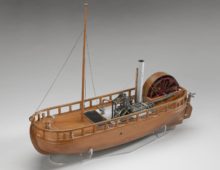Tagged with Military
Resource : Prosthetic leg of Earl of Uxbridge
This is one of three prosthetic legs made for Henry Paget, Earl of Uxbridge, who commanded the British cavalry at the Battle of Waterloo.
Resource : Napoleon’s Hat
This hat was worn by the French Emperor Napoleon when he commanded the French Army at the Battle of Waterloo. The hat was a vital part of the image of a hard-working, down-to-earth leader that Napoleon tried to create. His profile was instantly recognisable to French soldiers, most of whom were devoted to him. The red, white and blue cockade, pinned to the hat, is a symbol of the French Revolution.
Resource : The Radetzky March by Johann Strauss I, performed by the Vienna Philharmonic orchestra, conducted by Franz Welser-Möst at the New Years Day concert 2011
Johann Strauss the elder was one of Europe’s leading composers and conductors during the Age of Revolution. Known particularly for dance music, he became known as the father of the Viennese Waltz. This march was commissioned to celebrate the victory of Austrian troops over Italian revolutionaries in the 1848 European revolutions.
Resource : Waterloo Descendants Book addition offers link to American Industrial Revolution
August 27, 2019 - Richard Moss
A new upload to the Waterloo Descendants Book uncovers the story of a Waterloo veteran with a family link to the American Industrial Revolution Waterloo 200 launched the Waterloo Descendants Book with the online Book Company in 2015 to feature the untold stories of the soldiers who fought at the Battle of Waterloo. Descendants and […]
Resource : Battlefield Injuries Illustrated by Charles Bell
This entry includes graphic illustrations of war injuries which some may find upsetting.
This is a watercolour painting by Charles Bell, a British Army surgeon who helped to treat the wounded after the Battle of Waterloo. His haunting paintings are stark reminders of what early 19th century battle injuries were like. They are rare images executed by a practising surgeon and artist, which was an unusual combination. While his portraits powerfully show the agony and trauma experienced by these young men, they also describe their wounds with anatomical accuracy.
Resource : The Plumb-Pudding in Danger
This print was one of over a thousand satires produced by the celebrated caricaturist, James Gillray, who became known as the ‘father of the political cartoon’. In the 18th century, cartoons and caricatures were a popular way of mocking the establishment and calling them to account. They would be discussed and enjoyed in shop windows, coffee houses and taverns. The arrival of the industrial printing press in the 1800s helped to spread them far and wide, through broadsides (posters), newspapers and pamphlets. This one was inspired by the resumed hostilities and ongoing rivalry between Britain and France in 1805.
Resource : Bone ship model
During the Revolutionary and Napoleonic wars, prisoner exchanges between Britain and France only occurred rarely, meaning large numbers of captives were held for long periods in each country. French prisoners in Britain were often invited or compelled to practice crafts, and manufactured many intricate models made from bones and other recycled goods.
Resource : Nelson’s Coat
This coat was worn by Admiral Lord Horatio Nelson when he commanded the British fleet at the Battle of Trafalgar, in 1805. In this major sea battle, the British navy defeated the combined fleets of the French and Spanish navies, temporarily ending Napoleon Bonaparte’s threat to invade Britain. Although this coat made Nelson highly conspicuous during the battle, he chose to wear it on deck to inspire his men. Nelson was shot at the height of the battle and mortally wounded. The bullet hole can be seen on the left shoulder of the coat.
Resource : La Marseillaise
Soldiers have always sung to keep their spirits up, and wars always produce songs. The Marseillaise is one of the most memorable war songs ever written. It tells us about the hopes and fears of French soldiers in 1792, during the French Revolution. In 1795 it became France’s national anthem and is now known today all over the world.
Resource : The Colours by The Men They Couldn’t Hang
This song tells the story of the Nore mutiny in 1797 and the execution of its ‘chief mutineer’ Richard Parker. It illustrates the British government’s fear of protest and potential uprising and the harsh punishments inflicted on those suspected of causing unrest.


